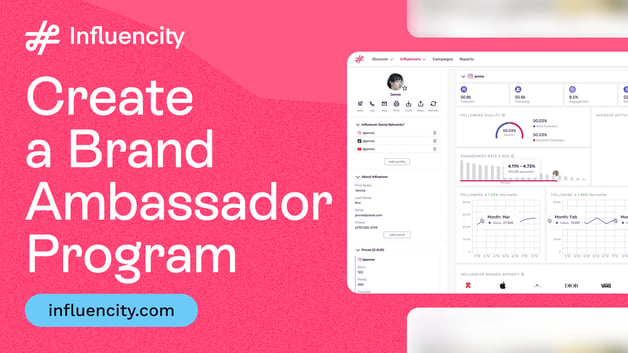In influencer marketing, ensuring clarity and mutual understanding is crucial to the success of any collaboration. Influencer marketing is a rapidly growing industry, and with it comes the need for legally sound and mutually beneficial influencer contracts. A well-written influencer agreement can help to ensure that both the influencer and the brand are on the same page and that their expectations are clearly outlined.
This guide provides a comprehensive checklist for creating an influencer agreement scope of work. By incorporating these essential components in your influencer marketing plan, both brands and influencers can establish a clearly defined partnership where the needs of both parties are met while minimizing the risk of misunderstandings or disputes.

Influencer Agreement: How to Define the Contract Scope of Work
When you create an influencer agreement, one of the key steps is defining the scope of work. This section of your influencer agreement clearly outlines what the influencer is expected to do, the deliverables they need to provide, and the overall expectations for the collaboration. By laying out these details upfront, you help avoid confusion and ensure both parties are on the same page from the start. A well-defined scope of work will guide the entire project, keeping everyone focused and aligned on the campaign’s goals.
In the following sections, we’ll walk through the 14 key elements to include in your influencer agreement scope of work, including content requirements, deadlines, approval processes, and more.
1. Introduction
The first section of your influencer agreement should serve as an introduction to the collaboration between your company and the influencer you have chosen to hire for your influencer marketing collaboration.
Specifically, the introduction section of your influencer agreement should include the following information:
- The legal names and addresses of both parties (the influencer and the brand)
- The purpose of the contract
- The effective date of the contract
- The duration of the contract (term), including the start and end dates of the partnership.
- Any provisions for contract renewal.
Additionally, if the influencer is represented by a talent agency, include the agency’s contact details. This can prevent confusion about who manages negotiations or legal matters.
2. Scope of Work
The scope of work section of your influencer agreement should clearly define the influencer's responsibilities and deliverables under the contract.
This usually includes the following:
- The type of content that the influencer will create (e.g., blog posts, social media posts, videos, etc.)
- The number of posts that the influencer will create
- The social media channels on which the influencer will post
- The specific hashtags and mentions that the influencer will use
- The deadlines for creating and posting content
You may also want to specify if the influencer is required to engage with their followers by responding to comments or questions related to the post. This can increase engagement and improve campaign success.
For example, you could include:
"The influencer agrees to respond to at least 10 relevant comments per post to boost engagement and build brand interaction."
3. Compensation and Payment Terms
The compensation section of your influencer agreement should clearly outline your compensation strategy, including the payment amount, frequency, and method of payment. Compensation might be in the form of a flat fee, a commission on sales, or a combination of both.
This section of your influencer agreement should also specify any additional expenses that will be reimbursed, such as travel or production costs.
If your campaign involves performance-based payments (e.g., bonuses for reaching certain metrics), be clear about how and when those payments will be calculated and disbursed. Include details about how performance will be tracked, especially if using third-party analytics tools.
For example, you could offer bonuses if the influencer exceeds certain engagement or conversion metrics:
"A bonus of $500 will be awarded if the post reaches 10,000 likes and 200 comments within the first 48 hours."
4. Content Guidelines
The next section of your influencer agreement should provide detailed instructions on the style of content that the influencer is expected to create, including brand guidelines, tone, messaging, and any specific requirements related to the promotion of products or services. This includes whether the influencer should incorporate certain calls-to-action, and any limitations on the use of competitor brands in their content. This section serves as a crucial roadmap for the influencer, helping you create a cohesive and effective brand image across various platforms.
For example, if you have hired a local Instagram influencer, provide detailed instructions that ensure their content resonates with your targeted regional audience. This might include incorporating local trends, events, or cultural nuances that align with your brand's image.
Finally, clarify whether content needs to be pre-approved by the brand before posting. This prevents miscommunication and ensures alignment with the brand’s vision.

5. Exclusivity and Conflicts of Interest
Make sure your influencer agreement addresses any exclusivity clauses that prevent the influencer from promoting competing brands or products during the contract period. Include guidelines on how to handle conflicts of interest that may arise during the partnership.
It’s also wise to specify a time frame (e.g., three to six months) following the campaign in which the influencer cannot promote competing products. This protects your brand’s association with the influencer for a reasonable period after the campaign ends.
For example:
"The influencer agrees not to collaborate with direct competitors of the brand for 3 months following the completion of this contract."
6. Intellectual Property Rights
The intellectual property section of your influencer agreement should define who owns the rights to the content that the influencer creates under the influencer contract (the brand or the influencer). This is important to protect both the influencer and the brand.
If you want the option to reuse the content in future campaigns or for other marketing purposes (e.g., in ads or email newsletters), specify this in the contract and include the duration of content usage rights. Be clear if the influencer retains any rights to use the content on their own platforms beyond the campaign.
For example:
"The brand may use the influencer’s content for promotional purposes for a period of 12 months after the contract ends."
Or:
"The brand reserves the right to repurpose the influencer’s content for use in paid ads, website banners, and email marketing."
7. Disclosure and Compliance
Include a clause in your influencer agreement that ensures the influencer will comply with all relevant laws, regulations, and industry guidelines, including disclosure requirements for sponsored content and endorsements.
In particular, influencers should follow the Federal Trade Commission (FTC) guidelines (or local regulations, if applicable) on clear and conspicuous disclosure of sponsored content. Be sure to specify exactly how the influencer should disclose partnerships, such as using hashtags like #ad or #sponsored.
For example:
"The influencer must include #ad or #sponsored in the first three lines of each post to comply with FTC regulations."

8. Indemnification
Outline the responsibilities of each party in the event of any legal claims, disputes, or liabilities arising from the content or actions of the influencer. Clarify how any damages or legal fees will be handled.
For example:
"The influencer agrees to indemnify the brand for any third-party claims resulting from the influencer’s unauthorized use of intellectual property."
In addition, make sure the influencer is responsible for complying with third-party platform rules (e.g., Instagram or YouTube policies) to prevent the brand from being liable if content is removed or penalized by the platform.
9. Termination Clause
The termination clause of your influencer agreement should reiterate how long the contract will last and how either party can terminate the contract.
This clause should also specify any penalties or obligations in the event of early contract termination.
In addition, consider including a "morality clause," which allows you to terminate the contract if the influencer engages in behavior that could damage the brand’s reputation (e.g., inappropriate social media activity or illegal actions).
For example:
"The brand reserves the right to terminate the contract if the influencer engages in any activity that could damage the brand’s reputation, including illegal or unethical behavior."
10. Performance Metrics and Reporting
Define the key performance indicators (KPIs) that you will use to measure the success of the influencer's marketing efforts. Include provisions for regular reporting and the review of performance against predetermined benchmarks.
Specify how often the influencer should share engagement data (e.g., likes, shares, clicks) with you. If possible, include access to metrics through platform tools like Instagram Insights or YouTube Analytics to verify results.
For example:
"The influencer will provide engagement metrics from Instagram Insights or equivalent platform analytics within 5 days of posting."
Or:
"The influencer is expected to achieve at least a 3% engagement rate per post and 100 swipe-ups on Instagram Stories."
11. Confidentiality
Include a confidentiality clause in your influencer agreement that prohibits the influencer from disclosing any confidential information about the brand or campaign. This might include information about your brand's products or services, marketing plans, or financial data. That way, any sensitive data that you share will be legally protected.
Make sure the confidentiality clause remains in effect after the contract ends to prevent future leaks of proprietary information.
12. Dispute Resolution
Specify the preferred method for resolving any disputes that may arise during the contract period, such as mediation or arbitration. Include the jurisdiction and governing law that will apply in the event of legal action.
Consider adding a timeline for dispute resolution to your influencer agreement to prevent issues from dragging on indefinitely, which could disrupt the campaign.
13. Amendments and Modifications
Clarify the process for making changes or amendments to the influencer agreement and specify that any modifications must be agreed upon in writing by both parties.
It’s helpful to include a clause that allows the contract to be revisited at specific points, especially in long-term campaigns, to ensure it’s still meeting both parties’ needs.
For example:
"Both parties agree to revisit the contract terms after the first 30 days of the campaign to ensure continued alignment and success."
14. Signatures and Execution
The final section of your influencer agreement relates to signatures and execution. Provide space for the signatures of both parties and include the date of signing to validate the agreement. Finally, ensure that each party has the authority to enter into the contract on behalf of the respective entity.
Provided you include all the above information in your influencer agreement, you will establish a solid foundation for a successful and mutually beneficial partnership, safeguarding the interests of both parties and setting the stage for a creative and strategic alliance that elevates your brand's visibility and grows your business.

Do's and Don'ts for Effective Influencer Contracts
We are going to end today's guide by sharing some important do's and don'ts for creating effective influencer agreements. These simple tips will help you make sure your contract is clear, fair, and legally sound.
|
Do’s
|
Don’ts
|
- Be specific about deliverables: Clearly describe what content the influencer will create and how often.
- Set deadlines: Include when content should be submitted and when it should go live.
- Outline performance expectations: List key metrics (e.g., engagement rate or views) so both parties know how success will be measured.
- Clarify content ownership: State who owns the content after it’s created and how it can be reused.
- Include payment terms: Detail how much the influencer will be paid, when, and through what method.
- Add compliance requirements: Make sure the influencer agrees to follow disclosure laws (like adding #ad or #sponsored).
|
- Don’t rely on verbal agreements: Always get everything in writing to avoid confusion.
- Don’t skip the content approval process: Review the content before it goes live to make sure it matches your brand’s message.
- Don’t forget exclusivity: Prevent the influencer from working with competitors during your campaign.
- Don’t leave performance undefined: Always include clear expectations for how the campaign will be measured.
- Don’t ignore legal protection: Without indemnity clauses, your brand could face legal issues.
- Don’t overlook communication: Regular updates and open communication are key. Avoid leaving the influencer without clear guidance or feedback during the campaign.
|
By following these simple do's and don’ts, you’ll create an influencer agreement that protects both parties and sets the stage for a smooth and successful collaboration.






![EBOOK Top 15 legal Questions Brands & Agencies Have About Working with Influencers [Answered by Legal Experts] Navigate the legal landscape of influencer marketing with our free eBook. Discover key strategies to ensure compliance and protect your brand.](https://no-cache.hubspot.com/cta/default/3449185/interactive-179420471352.png)



















%20and%20How%20Can%20They%20Benefit%20Your%20Brand%20article.jpg?length=628&name=What%20Are%20Key%20Opinion%20Leaders%20(KOL)%20and%20How%20Can%20They%20Benefit%20Your%20Brand%20article.jpg)








